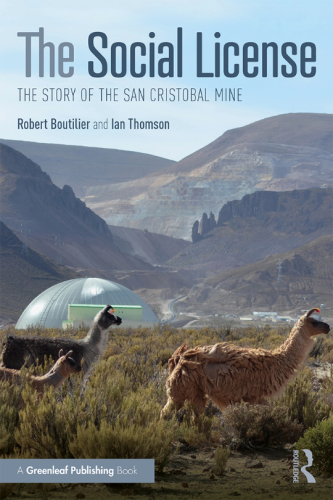SOCIAL LICENSE – THE BOOK
Robert Boutilier and Ian Thomson are pleased to present their book published by Routledge- Greenleaf entitled ‘The Social License – The history of the San Cristobal Mine’.

This unique book combines a colourful history of Bolivian politics with some of the most advanced quantitative techniques yet developed for socio-political risk analysis. This is the story of how a foreign-owned private sector mining company – Minera San Cristobal – earned, lost, and regained its social licence to operate (SLO).
Robert Boutilier and Ian Thomson transform the concept of the SLO from a metaphor to a management tool. The book traces the development of new concepts and measures in the field of stakeholder engagement while following the narrative of a community struggling with a fundamental change in its identity from a declining, malnourished llama-herding village to one of the richest towns in Bolivia.
This remarkable story will inspire practitioners in the field of stakeholder management; it will provide an invaluable roadmap for professionals working on land re-use projects in the energy, mining, and conservation sectors; it will make stakeholder relations concepts and techniques accessible to students through an engaging and in-depth case study; and it will open your eyes to one of the most fascinating accounts of how two different cultures collided and then came together to address different but aligned goals. Early reviews include:
"An engaging and unique mix of historical context, social science theory, novel data, visualizations and quotes from the front lines where indigenous communities and multinationals negotiate rents, rights and right."
Witold Henisz, Professor of Management at The Wharton School, The University of Pennsylvania, USA
"A readable and thoughtful exploration of the theories and practice of relationships between mining companies and communities. Useful for anyone interested in community development or mine development."
David Clarry, Vice President, Corporate Social Responsibility, Hudbay Minerals Inc., Canada
"So well written, truly a pleasure to read, not to mention absolutely fascinating."
Pamela Lesser, Faculty of Social Sciences, University of Lapland, Finland
Copies of the book may be obtained from the publisher at www.routledge.com
The book is divided into four parts. Part One (Historical Context) has four chapters that set the cultural and political context while describing a framework for understanding company-community conflicts. In Part One, we discuss the historical roots of differences between the MSC as a corporation and the Bolivian communities, culture, and institutions around the mine.
Chapter 1 focuses on the history of local communities while Chapters 2 to 4 look at the broader historical roots of conflicts and debates in Bolivia and at a few social science concepts that help make sense of them.
Chapters 5 to 9 make up Part Two (Retrospective from Discovery to Routine Operation). Here we look at the details of the relationships between the communities and the various companies that sequentially owned and developed the mineral deposit from 1994 to 2011. Chapter 5 introduces the formal version of the concept of the social license and describes the qualitative study methods used to acquire the information reported in Chapters 6 to 9. Chapter 6 covers the 10-year pre-construction period from 1994 to 2004. Chapter 7 covers the construction stage, which lasted from 2004 to 2006. Chapter 8 deals with issues of adjusting to mine operation from 2007 to 2009 but also includes the issue of water, which is a chronic issue that reached its point of maximum controversy in 2009. Chapter 9 focuses on two notable conflicts that occurred in 2010 and 2011 respectively.
Part Three (Stakeholder Strategies from Quantitative Measures) contains Chapters 10 to 12. This is where we highlight the quantitative techniques we have developed for analysing socio-political risks and how they helped generate strategies for maintaining a social license to operate. Chapter 10 describes the quantitative study methods developed and refined at MSC from 2009 to 2015. Chapter 11 summarizes the findings of the qualitative study for five intervals of approximately 15 months each from 2009 to 2015. Chapter 12 covers the same time period with a focus on the strategies developed for raising the level of social license and the initiatives undertaken to implement the strategies.
Part Four (Distinctive Features and Conclusions) contains chapters 13 to 15. Chapters 13 and 14 touch on two topics that make the relationships distinctive: women mine workers and the territoriality of llamas. Chapter 15 concludes with lessons learned about earning and maintaining a social license in mining in general.
